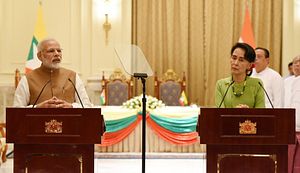Earlier this week, we saw another round of headlines tied to Myanmar’s receiving of its first-ever submarine from India. The focus on the capability addition, which has been the subject of speculation over the past few months, has once again spotlighted its significance both for Naypyidaw as well as the wider region.
As I have noted before in these pages, Myanmar has long been mulling the pursuit of a submarine capability in recent years, with periodic reports surfacing over the past decade or so about Naypyidaw’s desire to acquire either submarines or supporting technical capabilities such as submarine training linked to various sources including India and Russia. And with Myanmar’s immediate neighbors either recently acquiring subs or moving toward doing so – Bangladesh already has the capability and Thailand has inked a deal to do so in the next few years – that quest has been seen as even more urgent for the military.
Earlier this year, we saw a more concrete indication of inroads on this front, with media reports surfacing that India would transfer over one of its Russian-made Kilo-class diesel-electric attack submarines, the INS Sindhuvir, to the Myanmar Navy (MN) later this year after refitting. And with the submarine reportedly commissioned earlier this month before the expected end of year deadline for its transfer, we have seen a new round of headlines tied to this development as well as its potential implications.
For Myanmar, the acquisition of its first submarine represents the realization of a longtime quest for the capability that could pave the way for future inroads, with more direct training and familiarization than in the past then leading to more submarine purchases from Russia. It is also consistent with the wider emphasis it has placed on developing its maritime capabilities, with some of the additional platforms of significance on full display earlier this week at the 72nd anniversary celebrations of the MN, where vessels including Myanmar’s first-ever landing platform dock amphibious assault ship entered into service.
But it also the move also has implications for the wider region. The transfer itself is testament to the increasing security role that India is playing in the Indo-Pacific in general and Southeast Asia in particular, as evidenced by the continued trajectory of the wider India-Myanmar defense relationship (despite Naypyidaw’s strained ties with Western counties) and other developments such as the expected Brahmos missile sale to the Philippines. The added capability for Myanmar is also unsurprisingly being watched by neighboring Southeast Asian states such as Thailand since it has consequences for the regional balance of power in mainland Southeast Asia. More broadly, irrespective of the stated motivations, the development will partly be viewed through the lens of Sino-Indian rivalry, with India’s submarine transfer to Myanmar seen as a reaction to Beijing’s involvement in submarines with respect to Bangladesh and Thailand.
To be sure, it is important not to prematurely overstate the importance of capability additions such as these. While the transfer of a secondhand diesel-electric submarine represents the realization of Myanmar’s longtime quest, it is a modest capability addition. The impact will rest not just on acquisition of the sub, but how it is equipped and maintained over time with proper money, manpower, and technology as well as how it operates jointly with other capabilities, aspects which we still know very little about publicly and remain difficult for even more capable Southeast Asian states to manage. And even as Naypyidaw considers how it advances its submarine ambitions in the future, it will continue to do so amid a recognition of the manifold internal and external security challenges it faces as well as the limitations that remain for it in the maritime realm.
Nonetheless, Myanmar’s realization of its submarine quest is no small feat and is not without significance for both Naypyidaw and the wider region. As such, how this shapes up in the coming months and years will continue to be of interest to regional observers.

































